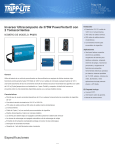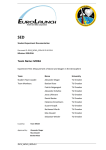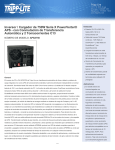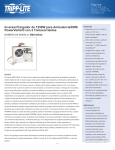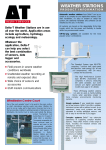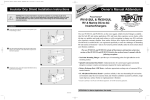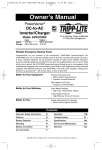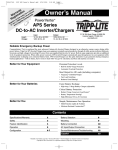Download Paper - Asee peer logo
Transcript
Session #2259 Development of a Real Time, Industrially Hardened, Ski Performance Analysis System Christopher A. Kilraine, James W. Shevock, and Dr. Peter J. Shull The Pennsylvania State University, Altoona Campus Abstract At Penn State Altoona, as a senior design project in the Electro-Mechanical Engineering Technology department, we have developed an instrumentation system to measure the dynamic response of skis under real time skiing conditions. The intent is to monitor the ski response during different styles of high performance use. Consequently, initial modeling and static testing were required to determine both sensor type and placement to capture the critical parameters during a specific ski maneuver. Apart from the determination of sensor type and optimum placement, environmentally hardening (handling of large temperature variations and large and rapid loading) of the system proved challenging. The specific measurements performed were ski displacement and acceleration. In this work, we will discuss the design and construction processes, the testing processes, and the specific results of the static and dynamic testing. This information and testing system, which is coordinated with ski manufacturers, will then be available for the future redesigning of skis for specific performance constraints such as freestyle or slalom. Introduction The use of sophisticated industrially hardened data acquisition (DAQ) tools and software along with instrumentation is a growing field in industry. The applications cover a very broad range from measuring human biomechanics to the thermal conductivity of fluids in motion. 1, 3 The typical process of instrumentation and data acquisition is as follows. Transducers are applied to the system to measure some physical quantity and convert it into an electrical signal. This electrical signal must sometimes be amplified and electrical noise must be filtered. These electrical signals are then converted to digital format for data storage in a data acquisition device. 5 The collected data can then be retrieved and uploaded to a number of software packages for analysis. “Proceedings of the 2003 American Society for Engineering Education Annual conference & Exposition Copyright © 2003. American Society for Engineering Education” Page 8.420.1 While the concept of monitoring of a physical event is simple enough, the difficulty arises when the system must perform outside a laboratory-type setting. 4 Currently most ski analysis systems measure static response in a laboratory setting. 9 The associated DAQ equipment is not designed to handle the harsh environment in which actual skiing is performed. Additionally, ski loads are primarily dynamic. Therefore, the design of a system that can withstand the environmental conditions of a ski slope and acquire dynamic real time data is a significant challenge. However, the resultant data and subsequent analysis offers significant insight into ski behavior for ski users and designers/manufacturers. Additionally, the value of this project exists on multiple levels for engineering and engineering technology students. Firstly, it prepares the students for developing system test schemes as is done in industry. Many businesses are now eliminating testing departments and are requiring that the design engineers test their own projects. So, it is essential that new graduates have some familiarity with instrumentation and data acquisition systems. 4 Secondly, it gives the students an opportunity to develop a project that is open-ended as opposed to a strictly defined design project. The general project scope and goals provide direction, while the undefined result allows for creative design alterations. Lastly, the students get to experience and work with a project from birth to completion. This allows the students to participate and obtain experience in all phases of a design project. Design Issues and Design Criteria The project goal is defined as developing a real time, industrially hardened, ski performance analysis system. To begin, the team chose specific types of measurements that were to be taken (acceleration, force, and displacement). It was determined that strain gauges and accelerometers would work well to measure the parameters. The transducers needed to be able to withstand rapid load changes and extreme temperature changes. Before purchasing sensors, a compatible data acquisition unit had to be found. The minimum specification requirements of the data acquisition system were defined as follows: • • • • • • • Must have at least 8 analog double ended channels Must have a minimum sample rate of 5 kHz per channel Must have a minimum memory amount of 100 MB Must be portable and able to be powered from a dc battery power source Must be industrially hardened to withstand cold temperatures, moisture, and vibration Must be within a reasonable price range Preferably have built-in signal conditioning for strain gauges and accelerometers Due to budgetary constraints, the team had to extensively search for a system to meet the minimum specifications. The data acquisition system selected (the Omega OMB-LogBook 300) was very versatile and met all the requirements except it did not have the desired built-in signal conditioning. The software for acquisition configuration was LogView 2.3, and the data viewing software was PostView 3.4. For the system to read analog inputs, the DBK 11A expansion card with screw terminals was purchased. For remote system control during testing, the LBK 1 remote terminal was purchased. The block diagram of the system identifies the connection scheme of all the hardware, Figure 1. Page 8.420.2 “Proceedings of the 2003 American Society for Engineering Education Annual conference & Exposition Copyright © 2003. American Society for Engineering Education” Figure 1: LogBook 300 Block Diagram 6 The strain gauges were required to have a fast response time, be able to adhere to a ski in harsh environments, and withstand repeated and rapid loading. The strain gauges selected were the Omega single-axis and the rosette (tri-axial). The accelerometers were required to have a fast response time, be able to function in harsh environments, and be able to create positive and negative voltage signals. The accelerometers selected were the PCB Piezoelectronic ICP 353B03. The skis used in the project needed to be of the newest model and used for reliable and accurate results. Ski manufacturers were contacted and asked to donate sample skis for the project. Many skis were used during preliminary testing. The skis used in the final test setup were the Elan Integra model. “Proceedings of the 2003 American Society for Engineering Education Annual conference & Exposition Copyright © 2003. American Society for Engineering Education” Page 8.420.3 Mounting Sensors for Preliminary Testing To mount the strain gauges to the skis, a seven-part adhesion method from Measurements Group, Inc. was used. 7 The adhesion process consists of degreasing and sanding the ski surface to remove impurities. Chemical cleansing with buffering agents was done to neutralize and acidic/basic residue on the surface. The strain gauge was glued to the surface with an M-bond 200 epoxy. To mount the accelerometers, a stud mount was used. The ski was drilled through and the hole was thread tapped. A thin layer of petro wax was spread over the base of the accelerometer to ensure solid surface contact. The stud screw was turned into the ski, and the accelerometer was threaded onto the stud screw. A mounting diagram can be seen in Figure 2. Figure 2: Mounting diagram for accelerometers 8 Preliminary Testing The team had to determine what range of signals the sensors selected could create. To measure the output of a strain gauge, a two-wire Wheatstone bridge circuit (quarter bridge) was constructed. A wiring diagram and a photo of this preliminary circuit can be seen in Figure 3. Figure 3: Wiring diagram 7 and photo of Wheatstone bridge circuit “Proceedings of the 2003 American Society for Engineering Education Annual conference & Exposition Copyright © 2003. American Society for Engineering Education” Page 8.420.4 The single-axis strain gauges were mounted to a test ski and subjected to a 3-point loading test. The ski was placed on blocks near the endpoints and loaded at the center of the binding. The output voltage (from a +5 V dc source) was measured with a Hewlett Packard 34401A DMM. A voltage range of –7 to +7 mV was measured for maximum deflection. The sample test ski can be seen in Figure 4. Figure 4: Portion of test ski with single-axis strain gauge Temperature compensation is a concern with strain gauge measurements. 7 The strain gauge output was measured at block heights of 1 to 6 inches with the ski and gauge at room temperature (approximately 68°F). The test ski was then cooled to 27°F and retested at the same temperatures. No significant change was found in the output voltage, so temperature compensation was not needed. The accelerometers were first tested while unattached to the ski. The accelerometers were signal conditioned through a PCB Piezoelectronics ICP Sensor Signal Conditioner, model no. 482A22. The accelerometers were shaken vigorously and subjected to impact loads by being dropped onto a concrete surface. The range of outputs for the accelerometers output signal were –50 to +50 mV. The sensor outputs were acceptable for the data acquisition system, and the final test ski was then instrumented. Instrumentation of Final Test Ski The attachment techniques used during preliminary testing were applied in the instrumentation of the final test ski. Four accelerometers (A), four single-axis strain gauges (SG), and one rosette strain gauge (RSG) were mounted to the ski. The placement of sensors can be seen in Figure 5. Data Acquisition Programming and Hardware The data acquisition hardware and software have been identified in the Introduction section of this work. The system had to be configured through the LogView software for a test of the acquisition. Once the configuration setting was established, the settings were downloaded to the LogBook. The remote system control module was used to trigger the start of the acquisition. During test acquisitions, the ski was flexed and vibrated. The primary configuration settings are shown in the LogView windows in Figure 6. Page 8.420.5 “Proceedings of the 2003 American Society for Engineering Education Annual conference & Exposition Copyright © 2003. American Society for Engineering Education” A RSG SG A SG Figure 5: Instrumented final test ski front (top), mid-section (middle), and rear (bottom) Page 8.420.6 “Proceedings of the 2003 American Society for Engineering Education Annual conference & Exposition Copyright © 2003. American Society for Engineering Education” Figure 6: Data acquisition configuration interface windows and settings To connect the sensors to the acquisition unit, the DBK11A card was used. The screw terminals are pin connections for the analog inputs, and some pins have references voltages (+/- 5V dc, + 15 V dc, and low level ground). An illustration of the connected data acquisition card can be seen in Figure 7. Page 8.420.7 Accelerometer BNC inputs “Proceedings of the 2003 American Society for Engineering Education Annual with copper conference & Exposition Copyright © 2003. shielding American Society for Engineering Education” Strain gauge differential inputs Parallel port connection to DAQ system Figure 7: DBK11A input/output card for analog inputs In the test acquisitions, the accelerometer data appeared to be clean of electrical noise. Therefore, no additional signal conditioning of the accelerometers was necessary. However, the strain gauge data exhibited significant noise. The team decided to develop and construct a signal-conditioning module for five strain gauges. Resolving Issues from Preliminary Testing To eliminate the electrical noise on the strain gauge output signals, a signal-conditioning module for five strain gauges was designed and constructed. This was accomplished by etching a circuit board and soldering in electrical components. The board consisted of five Wheatstone bridge circuits with extensive grounded electrical shields. The circuit was designed with10 kΩ resistors and 10 kΩ potentiometers. Capacitors were placed across the strain gauge leads to reduce noise. An illustration of the signal-conditioning module can be seen in Figure 8. Strain gauge leads Potentiometers Capacitors Resistors Leads for measuri ng voltage signals Figure 8: Illustration of strain gauge signal conditioning module “Proceedings of the 2003 American Society for Engineering Education Annual conference & Exposition Copyright © 2003. American Society for Engineering Education” Page 8.420.8 The team tested a new acquisition of only the strain gauges. The potentiometers in the circuit are variable to zero the voltage of each strain gauge channel while the ski is in the flat position. After the new test, the two single axis strain gauges located nearest the ski bindings never produced a signal change. It was determined that this was due to the lack of ski flex in those areas of the ski (thicker cross-sectional area). The signal-conditioning module was successful in increasing the signal-to-noise ratio to an acceptable level. The next step was to correlate ski deflection (strain) to the strain gauge voltage signals. The three-point loading test was done once again to stress the ski. The endpoint blocks were raised from 0 to 5 inches and the voltage outputs were measured with the DAQ system. A picture of the loading test can be seen in Figure 9 and the strain gauge data in Figure 10. Figure 9: Three point loading test for correlating strain gauge outputs to ski deflection (3 inch blocks) Figure 10: Strain gauge output signals for ski deflections of 0 to 5 inches in the 3-point load test “Proceedings of the 2003 American Society for Engineering Education Annual conference & Exposition Copyright © 2003. American Society for Engineering Education” Page 8.420.9 As seen in the data of Figure 10, the strain gauge outputs show a large variation of strain along the long axis of the flexed ski. The maximum strain appears in the gauge parallel to the long axis of the ski in the rosette strain gauge (tri-axial). The data correlating the displacement to the gauge output for the longitudinal gauge of the rosette is shown in Figure 11. Figure 11: Correlation data of longitudinal rosette strain gauge to ski deflection It can be seen in the data that there is a linear relationship between longitudinal strain and the output signal from the strain gauges. The next design challenge was to develop a portable power system for all instrumentation and data acquisition systems. Powering the Systems A design constraint of the project was that the systems had to be powered by dc batteries. The data acquisition system was specified as having operating voltage ratings of 10 to 30 V dc. The team simply modified a DIN5 connector to attach to a 12 V dc battery. The battery used was a BB BP4.5 model rated at 4.5 Ah. The DBK11A input/output card, the LBK1 terminal, and the strain gauge signal conditioning module all pull power from the DAQ system. Therefore, these systems did not require separate power sources. However, the accelerometer signal conditioner required a 36 V dc power source supplied on a DIN5 connector. The team could have achieved the 36 V dc by using three more 12 V dc batteries, but this would have made the system too bulky and heavy. Instead, an alternative solution was created. The accelerometer signal conditioner has a power converter that changes 120 V ac to 36 V dc on a DIN5 connector. The team found a Tripp Lite 140 W PowerVerter to transform 12 V dc to 120 V ac. The power from a 12 V dc battery was then fed into the PowerVerter to obtain 120 V ac. This signal was then sent into the power supply for the accelerometer signal conditioner. An illustration of the power solution can be seen in Figure 12. Tripp Lite PowerVerter Page 8.420.10 Original signal conditioner power “Proceedings of the 2003 American Society for Engineering Education Annual converter conference & Exposition Copyright © 2003. 12 Vdc battery American Society for Engineering Education” Figure 12: Power system to supply accelerometer signal conditioner Making the System Portable It was necessary to install the bulky equipment into a backpack so that the skier would not have restriction of movement while skiing. The leads to the sensors had to be wrapped in wire loom for protection against abrasion. A quick disconnect was installed on the sensor leads near the ankle area for easy ski removal without removing the backpack. The disconnect terminal and wire loom protection is illustrated in Figure 13. Lead disconnect (screw type) Wire loom protection Figure 13: Illustration of wire loom lead protection and lead disconnect “Proceedings of the 2003 American Society for Engineering Education Annual conference & Exposition Copyright © 2003. American Society for Engineering Education” Page 8.420.11 Illustrations of the items in the backpack and the entire system on a human can be seen in Figure 14. Figure 14: Setup of the portable system (left) and the system mounted on a human (right) Testing Procedures and Data Collected With all preliminary testing done, the system was tested under actual skiing conditions. Digital video footage was taken as the data was acquired while the skier was skiing down the hill. The test runs were segmented (approximately 30 seconds) with pauses in between to allow the video taker to move down the hill ahead of the skier. All systems held up fine until the fifth test run. One set of leads to a strain gauge was severed. This could have been due to an unseen obstruction in the snow or from limited elasticity in the wiring harness. It was determined that the implementation of a bungee cord connecting a loop in the wire harness would greatly improve the integrity of the system. The current harness does not allow for extreme mobility of the skier without straining the wire leads. The “shock absorbing” cord would reduce possibilities of failure and increase skier comfort. The data colleted was transferred from PostView to an Excel spreadsheet for analysis. Figure 15 shows measurements of the two front-most accelerometers. Page 8.420.12 “Proceedings of the 2003 American Society for Engineering Education Annual conference & Exposition Copyright © 2003. American Society for Engineering Education” 1 2 4 Accelerometer #1 data Accelerometer #2 data 3 Figure 15: Accelerometer test data from dynamic skiing Accelerometer #1 was closest to the front tip of the ski, and accelerometer #2 is the sensor directly behind it. The voltage spikes at points 1, 2, and 3 correspond to sharp turns. Point 4 shows the output signals as the skier stopped. It was noted by the team that the signals are inverted from one another. It was found that the positive and negative leads of the accelerometer were crossed in the wiring of the DBK11A input/output card. As initial testing proved, only one strain gauge provided a clear and decipherable signal. This strain gauge was the gauge in the rosette that is parallel to the longitudinal axis of the ski. Data for this sensor can be seen in Figure 16. Stopping point after carving exercise Maximum signal amplitude during carving exercise Figure 16: Output signal of strain gauge (longitudinal in rosette) during carving exercise “Proceedings of the 2003 American Society for Engineering Education Annual conference & Exposition Copyright © 2003. American Society for Engineering Education” Page 8.420.13 This strain gauge data was taken during a carving exercise. Carving is a ski term for making rapid turns from left to right. This exercise produced some of the highest signal outputs from the strain gauge due to the rapid change in direction. Upon inspection of the data, it was found that the maximum signal amplitude during the exercise was equal to 3.7 mV dc. The calibration chart in Figure 11 was used to correlate the 3.7 mV signal to a displacement. It was calculated that during the turn of maximum signal amplitude, the ski flex was similar to that in a 3-point load test using 3.2-inch blocks. The calculation is shown in Figure 17. ski displaceme nt = output signal (mV) (slope of calibratio n curve (mV/in) ) 3.7 = 3.2 inch blocks 5.8 - 0 5-0 * The slope of the calibratio n curve is assumed to be linear. = Figure 17: Calculation of displacement from calibration curve The analysis of the data could only be completed in part due to complicated linking of video footage to the data. The test intervals were extremely long (approximately several minutes), which made the data difficult to separate into parts that could be matched with the video. The video footage did not depict the terrain of the ski slope very well. Therefore, it is impossible to account for small bumps or dips in the terrain. The weak signals of all but one strain gauge made it impossible to determine ski-flexing parameters. The strain gauge signals need to be amplified to be of any use. Scope of Future Work The future intent of this project is for other engineering students to extend the project. Possible project extensions are, but are not limited to, the following: • • • • • • • • Develop a more efficient means of linking the video with data acquisition. This could be done by linking a flashing light to a pulse counter in the DAQ system. Implement better signal conditioning for the strain gauges by amplifying and filtering the signals. Apply different types of sensors (such as load cells and thermocouples) to measure other parameters. Run better ski tests and analyze the data further. Use high quality data for redesign recommendations to ski manufacturers. Use the data along with FEA to construct a virtual model of the ski. Instrument two skis to determine the quality of matching between the skis. Create a similar system for testing snowboards. Conclusions “Proceedings of the 2003 American Society for Engineering Education Annual conference & Exposition Copyright © 2003. American Society for Engineering Education” Page 8.420.14 This paper depicts a successful start to the design of a unique dynamic ski analysis system. The design of the data acquisition scheme worked well in measuring data from sensors. Slight modifications in the signal conditioning of the strain gauges by amplification will dramatically enhance the quality of the system. Reliable sensor mounting schemes have been developed, and the selected equipment met or exceeded expectations. Baseline data correlation between flexure and strain gauge output was calculated to model (in part) the ski under dynamic loads. This work also includes interesting extensions that the project will go through in the future. Acknowledgments The team would like to thank Dynastar, Elan, and Rossignol ski manufacturers for the donations of skis and bindings for the project. The team acknowledges and appreciates the financial support of the the Business and Engineering Division of Pennsylvania State University, Altoona Campus. A special thanks goes out to Mr. John Sjolander, Lab Coordinator, for all of his assistance throughout the course of the project. Bibliography 1. 2. 3. 4. 5. 6. 7. 8. 9. Abe, T. Gocho, T., Kiryu, T., Okada, M, and Ushiyama, Y. “Snapshot Evaluation of Fatigue During Skiing Exercises.” Engineering in Medicine and Biology Society, 1998 Proceddings of the 20th Annual International Conference of the IEEE. Vol. 5 p. 2775-2778. 1998. Boaventura, C., Cordeiro, M., Couto, C., Morais, R., Salgado, P., and Serodio, C. “Solar Data Acquisition Wireless Network for Agriculture Applications.” 19th Convention of the Electrical and Electronics Engineers in Israel. P. 527-530. 1996. Kostic, M. “Instrumentation with Computerized Data Acquisition for an Innovative Thermal Conductivity Apparatus.” ASEE Annual Conference Proceedings. Session 2659. 1998. Lekas, S. “Searching for the Right Data Acquisition Software.” Evaluation Engineering. vol. 35, no. 12, p. 14-20. December, 1996. McDonald, D., and Mahajan, A. “Data-Acquisition Systems: An Integral Part of Undergraduate Engineering and Technology Programs.” ASEE Annual Conference Proceedings. Session 1559. 1998. “OMB-LogBook User’s Manual, Stand-Alone, Intelligent Systems for 16-bit Data Acquisition and Logging,” Omega. Student Manual for Strain Gauge Technology. Measurments Group, Inc. Bulletin 309D. 1992. http://www.pcb.com/tech_accel.html. Diagram of accelerometer stud mounting. Retrieved from Internet at Penn State University, Altoona Campus. December 20, 2002. http://www.eng.utah.edu/~shorth/dynamic.html. “Dynamic Ski Testing.” Retrieved from Internet at Penn State University, Altoona Campus. August 29, 2002. Page 8.420.15 “Proceedings of the 2003 American Society for Engineering Education Annual conference & Exposition Copyright © 2003. American Society for Engineering Education”















